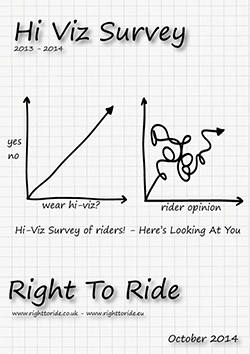 Ever since somebody took a 19th century “Sam Browne Belt” and adapted the concept by covering it with high-visibility cloth, then adding reflective material and wore it while riding a motorcycle, there has been a debate whether high-visibility (aka Day Glo or Hi Viz) actually helps riders’ visibility.
Ever since somebody took a 19th century “Sam Browne Belt” and adapted the concept by covering it with high-visibility cloth, then adding reflective material and wore it while riding a motorcycle, there has been a debate whether high-visibility (aka Day Glo or Hi Viz) actually helps riders’ visibility.
In 2011 to 2013, rumours were rife within the motorcycling community that EU legislators were on the verge of making the wearing of Hi Viz clothing mandatory for motorcyclists across Europe.
The Hi Viz debate still smoulders on and seems to re-ignite now and again, so we published a questionnaire in 2013 to gauge riders’ opinions about high visibility clothing.
The Survey
The survey was designed to be a simple questionnaire that did not need or require a large amount time to respond.
We did not ask what they thought if Hi Viz might be proposed to become compulsory, however the reaction by riders and their representative organisations about the rumour of EU compulsion demonstrates the strong feeling that there is on compulsion and not necessarily just about hi-viz.
Key Points
- Over the 15 month period, 235 riders replied and of these, 57.4% responded that they did not wear a Hi Viz jacket or vest.
- Proportionately more female riders replied that they did not wear Hi Viz compared to the male riders. In fact 76.5% of female riders replied that they did not, compared to 56% of male riders (although the sample size of female riders was considerably smaller).
- The age of the riders surveyed highlighted that 69% were aged from 45 years upwards, while 30.6% were aged under 45 years.
- Riders most likely to wear Hi Viz are mainly those up to the age of 34 and from 65 years onwards while those less likely to wear Hi Viz are in the age groups between 35 and 64, which were also the largest groups of riders.
- 37% resided in England, while 34.9% resided in Northern Ireland, with 6.4% in Scotland and Wales and 7.2% in the Republic of Ireland.
- When asked when they wore Hi Viz while riding, only 101 responded to the question and of these, 48.5% replied that they wear Hi Viz all the time, while 40.6% replied “now and then” and 10.9% replied that they only wore Hi Viz while commuting.
- 95 riders explained why they preferred to wear Hi Viz of which 60 responded that they wore Hi Viz to be seen, the remainder explained that they wore Hi Viz depending on the weather or situation – e.g. marshalling, work, commuting etc.
- 136 riders explained why they did not wear Hi Viz and the overwhelming majority were of the opinion that Hi Viz jackets or vests did not make any difference to their safety on the roads.
Right To Ride
As riders involved in road safety, the message to us is clear, which is that legislators, road safety policy makers or road safety organisations with influence who have a safety agenda affecting riders, not only need to take note of the “group” that they are trying to affect but they need to present facts and structured persuasion to influence riders’ attitudes or behaviours.
However in circumstances when riders have faith in their own destiny, then no matter how or why legislators and safety organisations present any proposed changes, this will lead to a clash between that “safety” group and riders mainly because of a lack of dialogue and respect of opinion, but as we have witnessed over the years, because of ignorance about what actually works and what does not.
We can conclude that riders are quite capable of making their own decisions on what they consider to be “safe” to wear whilst on the road.
Hi Viz Survey – Here’s Looking At You – pdf – 1.26mb – Click Here
Links Information
View our previous publications regarding Hi Viz – Click Here


I agree, road safety is a complex, issue.
Wearing hi vis may help you to be noticed but cannot guarantee it.
Every road user has a responsibility for their behaviour and attitude towards others.
I ride defensively wearing some hi vis incorporating a back protecter on a white bike with permanent headlights.
I still get cut up occasionally but so far I have avoided any accidents.
At 58 years of age that is not a bad record.
At the end of the day you are responsible for your own safety and should ride behave accordingly.